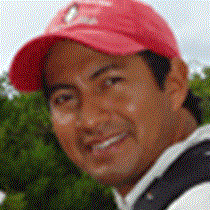Punta Vicente Roca, Isabela & Punta Espinoza, Fernandina
The beginning of what was going to be a successful day full of attractions and exciting encounters was reflected on the faces of the early risers as we started our search for marine life on the north side of Isabela.
Soon afterwards we spotted a pod of common dolphins that actually are not so common but a very special sighting in these waters.Cameras and binoculars in hand, we contemplated the dolphin parade as they leaped out of the water, giving us a show of their majesty.
As the trip continued getting close to the equator line, and taking pleasure in the splendour of the Galápagos volcanoes, King Neptune and his pirates appeared to claim some sacrifices to let us reach the southern hemisphere.
Once in the calm southern waters with the acceptance of King Neptune we boarded our Zodiacs to explore closely the coast of northern Isabela, which happens to be an area of Galápagos teeming with life of all kinds such as sea turtles, marine iguanas, penguins and flightless cormorants, to mention but a few.
“Whale! There she blows!” - arose a sudden voice as some body pointed westwards. Indeed there was a massive whale a couple of hundreds of yards away and as we approached we could identify it as a Bryde’s whale! Also in the area was a small school of ocean sun fish, which is one of the rarest types of organisms in the ocean.This same site has an amazing snorkeling area teeming with tropical fish, sea turtles, cormorants and penguins.
Upon departure we enjoyed an appetizing lunch as we headed towards Fernandina Island, which happens to be the youngest volcano in the Galápagos archipelago, dating under seven hundred thousand years old.
To visit Fernandina Island is like going back to the beginning of planet Earth, when the volcanic processes went on at a fast rate, shaping the landscapes and all the existing life forms. Most of this island is just a barren lava field where hardly anything grows, and the plants we have here are the hardy lava cactus that would erode the basaltic rocks to eventually give rise to new plants that will completely populate the island. So far the organisms most likely to survive in this harshness are reptile like lizards and snakes. The other surviving animals would be birds and others that live in mangroves around the shores.
We returned to our ship after a spectacular sunset on land, to share our highlights of a great day with our fellow travel companions.
The beginning of what was going to be a successful day full of attractions and exciting encounters was reflected on the faces of the early risers as we started our search for marine life on the north side of Isabela.
Soon afterwards we spotted a pod of common dolphins that actually are not so common but a very special sighting in these waters.Cameras and binoculars in hand, we contemplated the dolphin parade as they leaped out of the water, giving us a show of their majesty.
As the trip continued getting close to the equator line, and taking pleasure in the splendour of the Galápagos volcanoes, King Neptune and his pirates appeared to claim some sacrifices to let us reach the southern hemisphere.
Once in the calm southern waters with the acceptance of King Neptune we boarded our Zodiacs to explore closely the coast of northern Isabela, which happens to be an area of Galápagos teeming with life of all kinds such as sea turtles, marine iguanas, penguins and flightless cormorants, to mention but a few.
“Whale! There she blows!” - arose a sudden voice as some body pointed westwards. Indeed there was a massive whale a couple of hundreds of yards away and as we approached we could identify it as a Bryde’s whale! Also in the area was a small school of ocean sun fish, which is one of the rarest types of organisms in the ocean.This same site has an amazing snorkeling area teeming with tropical fish, sea turtles, cormorants and penguins.
Upon departure we enjoyed an appetizing lunch as we headed towards Fernandina Island, which happens to be the youngest volcano in the Galápagos archipelago, dating under seven hundred thousand years old.
To visit Fernandina Island is like going back to the beginning of planet Earth, when the volcanic processes went on at a fast rate, shaping the landscapes and all the existing life forms. Most of this island is just a barren lava field where hardly anything grows, and the plants we have here are the hardy lava cactus that would erode the basaltic rocks to eventually give rise to new plants that will completely populate the island. So far the organisms most likely to survive in this harshness are reptile like lizards and snakes. The other surviving animals would be birds and others that live in mangroves around the shores.
We returned to our ship after a spectacular sunset on land, to share our highlights of a great day with our fellow travel companions.




